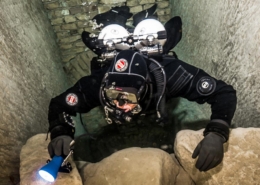Diving among the tall pines: A guide to diving the pit mines of Minnesota
By Mark Manthey
Being over one thousand miles from any ocean, you might think diving in Minnesota would be the pits. That’s actually not too far from the truth. For the avid scuba diver, the iron ore pit mines of Minnesota have a lot to offer. Northern Minnesota has about a dozen pit mines good for diving, and over 50 dive sites. Skill levels range from novice to technical and CCR. There’s also Lake Superior, but that’s another article.
A brief history
The iron ore pit mines of Minnesota opened in the early 1900s, and operations continue today. Being so close to the Great Lakes, they were a perfect fit for transportation to the steel mills in the East. However, because of this relationship, Minnesota not only has pit mines to dive but also shipwreck diving in Lake Superior. As the demand for ore declined in the 1960s, the mines were closed and started to fill with spring water after the pumps shut down. As scuba diving gained popularity, local divers started to explore.
Where to go
The largest concentration of pit mines is found in the Cuyuna country state recreational area, in Crosby/Ironton. Other popular locations include Lake Ore-be-gone in Gilbert, Lake Mine (Embrarras) in Biwabik, St. James in Aurora and Tioga pit in Cohassett.
Conditions
Visibility typically ranges from 20 to 40 feet. However, it can be less, depending on local conditions such as rainfall, time of year, pollen and algae blooms. The visibility is generally better deeper. Some pits have a hydrogen sulfide layer at about 100 feet. You can descend through it, but it will be very dark and disorienting. Water temps range from around 70°F at the surface in midsummer, to 38°F to 45°F at depth. The lake bottom often has fine silt. Good buoyancy control and frog kicking are important to avoid silting out the dive site. Thermal layers are generally found around 20 ft. and 50 feet. The depth of these mines ranges from 150 ft. to over 500 ft. deep.
Features
If you like wall diving, then you will love diving the pits. The bottom is very rocky with walls and shelves forming a sort of steps, making it great for multi-level, deep or tech diving. The walls range from 20 ft. to 50 ft. high, or more. As the mines went deeper, trees began to grow on the upper levels. When the mine closed, the trees became submerged, creating an underwater forest, preserved by the cold water. There are several intentionally sunk attractions for scuba divers. They include training platforms, airplanes, boats, helicopters, buses, cars, and one of my favorites, the mannequin of Jason Vorhees from the Friday the 13th movies, in Lake Louise. There are some, but not many, ruins from the mining operations. Fish spices in the lakes include sucker, sunfish, bass, crappie, walleye and lake trout. Although, they are usually frozen over from December to May. .
Logistics
Local dive shops often sponsor fun dives and special events throughout the summer months. Some of the pits have dives shops nearby for air fills, while others do not, so plan ahead. Camping, cabins and hotels are available in all areas. A quick internet search will provide plenty of information. On-site amenities vary.
Safety concerns
Some of the dive sites are off the beaten path, on roads not clearly marked or paved. Cell service can be spotty at times, so a good emergency plan is essential. Because of the cold water, 7mm wetsuits, dry suits, regulators designed for cold water use, high-capacity steel cylinders and alternate air sources (pony) are all highly recommended. Although, modern scuba gear is very reliable, regulators can free flow from time to time. Also, gas narcosis is common due to the deep depths and cold water, so watch yourself and buddies. The closest hyperbaric chamber is at the Hennepin County Medical Center in Minneapolis.
Diving the pit mines of Minnesota may not be like diving your favorite warm water reef, but, that’s the point. The challenges of scuba diving in these conditions will enhance your skills, making you a more skillful diver. Plus, who doesn’t like diving in most any conditions?









 Natalie L. Gibb
Natalie L. Gibb
Plaats een Reactie
Meepraten?Draag gerust bij!